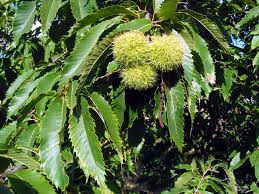Firewood Types: Sweet Chestnut
Firewood Types : Sweet Chestnut is one of the most common firewood types here in the south-east of England. Sweet chestnut used to be the main woodland type here, supporting a wide variety of woodland crafts. Chestnut is renowned for making excellent fence posts as it lasts well in the ground.
In recent years traditional chestnut coppicing has fallen into decline and the woodlands have been neglected. Chestnut coppice should be cut on a 14 year cycle, or there abouts, however much neglected (over-stood is the correct term) coppice has been uncut for 30 years or more.
Overstood coppice has little value to the traditional coppice workers, as the timber is usually of low value. Much overstood chestnut coppice is therefore sold as firewood or turned into charcoal.
What does it burn like?
Unfortunately sweet chestnut, despite being readily available, is not great to use as firewood. If you can give it two full years to season after cutting, splitting and stacking you can burn it with some degree of success in a wood stove but anything less than two full years of drying will be disappointing. Fortunately it splits very easily and the long straight poles are easy to harvest and process.
Sweet Chestnut also spits horribly, whether being burnt seasoned or unseasoned and for this reason should only be burned in a wood stove with a well fitting door.
The wood itself is of moderate density, unlike oak for example, so to provide the same amount of heat you will need to burn nearly twice as many logs. This is not in itself a problem if you have a plentiful supply like we do, but it takes time to cut and process it.
Sweet chestnut is one of the main woods that we burn here, what oak we get we tend to save for the colder weather.
Key points
- Chestnut needs two full years to season - don't try to get by with just one
- Chestnut spits terribly - don't plan to use in in an open fire or any wood stove with a poorly fitting door
- Chestnut has only moderate density - you may need more cords than you expect
- Chestnut is easy to fell, cut and split - nice wood to work with
On the plus side if you burn chestnut in the UK you are supporting the revitalisation of sustainably managed woodlands and, if you choose your supplier carefully, will be supporting traditional woodland crafts.
Gathering Sweet Chestnuts
If you have woodland with sweet chestnuts you will be able to gather nuts in autumn, from around October time. The nuts themselves are very tasty roasted on top of your wood stove (put down a layer of tin foil to protect the surface), just make sure you use a sharp knife to split the end. They have a tendency to explode if you don't!
The nuts grow best from older trees, not those in the normal coppice cycle. If you are working in woodland and find a specimen that produces prolific nuts consider leaving it as a larger standard when you coppice the surrounding area - you'll guarantee yourself a supply of nuts in future and any you don't eat will help support the local wildlife.

